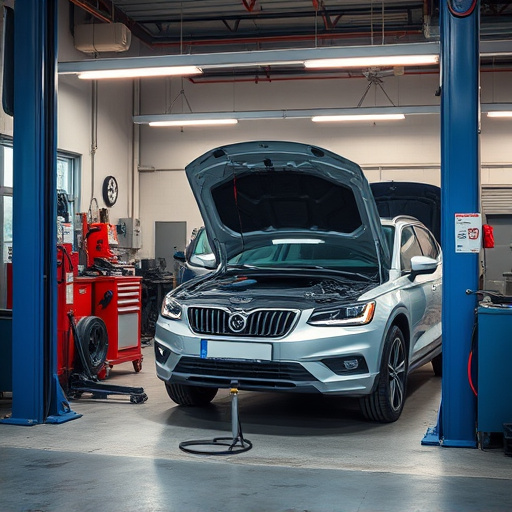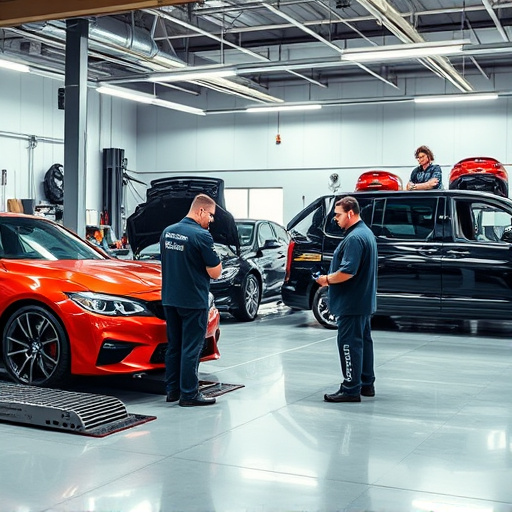Mastering Tesla Composite Repair: Interior Components Guide

Tesla composite repair demands specialized knowledge and precision due to the intricate nature of in…….
In the rapidly evolving landscape of automotive technology, Tesla has emerged as a pioneer, pushing boundaries with its innovative electric vehicle (EV) designs and advanced materials. At the heart of this revolution lies a critical aspect often overlooked yet pivotal to Tesla’s success—Tesla composite repair. This intricate process is not just about fixing damage; it involves a sophisticated understanding of composite materials, advanced repair techniques, and a commitment to sustainability.
In this article, we embark on an in-depth exploration of Tesla composite repair, unraveling its intricacies, global impact, economic implications, technological leaps, regulatory frameworks, and future prospects. By delving into these diverse aspects, readers will gain a holistic understanding of why Tesla composite repair is not merely a technical endeavor but a strategic cornerstone in the EV industry’s evolution.
Definition: Tesla composite repair refers to the specialized process of repairing and restoring structural components made from composite materials in Tesla vehicles. Composites, a class of advanced materials combining two or more constituents, offer exceptional strength-to-weight ratios, making them ideal for lightweighting vehicle structures, thereby enhancing energy efficiency.
Core Components:
Composite Materials: These include fiber-reinforced polymers (FRPs) such as carbon fiber reinforced polymer (CFRP), glass fiber reinforced polyamide (PA), and aramid fiber reinforced composites. Each material has unique properties, with CFRP being the most prevalent in Tesla vehicles due to its superior strength-to-weight ratio and corrosion resistance.
Repair Techniques: The repair process involves several steps: damage assessment, demolding (if necessary), surface preparation, repair of the composite layup using specialized resins and reinforcement, curing, and final inspection. Automated fiber placement (AFP) and automated tape laying (ATL) are often employed for large-scale production repairs.
Adhesives and Resins: High-performance adhesives and resins are critical to ensuring structural integrity. These materials must withstand extreme conditions, including varying temperatures, road stress, and corrosion.
Historical Context: The concept of composite repair in the automotive industry gained traction in response to increasing demand for lightweight, high-performance vehicles. Tesla, with its focus on sustainability and innovation, has been at the forefront of this movement. As Tesla vehicles age, efficient and effective composite repair methods have become essential to maintaining their structural integrity, safety, and resale value.
Significance: Tesla composite repair is pivotal for several reasons:
Tesla composite repair has transcended geographical boundaries, influencing global automotive trends and practices:
| Region | Key Developments |
|---|---|
| North America | Tesla’s home market has seen a surge in composite repair expertise due to the widespread adoption of its vehicles. Advanced training programs and specialized repair facilities have emerged to meet demand. |
| Europe | The European Union’s focus on reducing carbon emissions has driven interest in composite materials and repair technologies. Countries like Germany and Sweden are leading the way with innovative research and development. |
| Asia-Pacific | China, a significant EV market, is witnessing a rapid growth in composite repair capabilities. Japanese and South Korean automakers are also investing heavily in composite technology for their electric vehicle fleets. |
| Global Standardization | International standards organizations are collaborating to develop uniform guidelines for composite repair procedures, ensuring consistency and safety across borders. |
The global composite repair market is experiencing steady growth, driven by:
Major automakers and tier-one suppliers are investing heavily in composite repair infrastructure, training programs, and research to:
The introduction of automated fiber placement (AFP) and automated tape laying (ATL) machines has revolutionized composite repair:
Digital transformation plays a crucial role in Tesla composite repair:
| Technology | Impact |
|---|---|
| Computer-Aided Design (CAD) | Enables detailed digital modeling of composite components, facilitating accurate damage assessment and repair planning. |
| 3D Printing | Used for creating custom tools, jigs, and prototypes, enhancing repair flexibility and speed. |
| Augmented Reality (AR) | AR headsets guide technicians during repairs, providing real-time visual instructions and ensuring precision. |
| Data Analytics | Collects and analyzes repair data to identify patterns, optimize processes, and predict potential issues. |
Global policies and regulations significantly influence the composite repair industry:
Despite its many advantages, Tesla composite repair faces several challenges:
| Challenge | Solutions |
|---|---|
| Skilled Workforce Shortage | Invest in training programs and collaborate with educational institutions to develop a skilled composite repair workforce. Encourage knowledge sharing among professionals. |
| Costly Repair Processes | Optimize repair techniques and leverage digital technologies for precision and efficiency, reducing labor costs. Develop cost-effective composite materials. |
| Supply Chain Disruptions | Diversify suppliers and implement robust supply chain management strategies to mitigate material shortages. Foster partnerships for secure access to critical components. |
| Environmental Concerns | Adopt sustainable practices, including recycling composite waste and exploring bio-based materials. Implement efficient disposal protocols. |
| Regulatory Complexity | Stay updated with global regulations and collaborate internationally to establish consistent standards, simplifying compliance. |
A leading automotive repair center successfully restored a damaged Tesla Model S body panel using advanced composite repair techniques. The process involved:
A Chinese automaker implemented a sustainable composite repair program, achieving notable results:
The future of Tesla composite repair is filled with promising possibilities:
Tesla composite repair is not merely a technical niche but a dynamic field shaping the future of electric mobility. Its global impact, technological advancements, and strategic importance cannot be overstated. As the world transitions to sustainable transportation, efficient and effective composite repair processes will be critical to ensuring vehicle longevity, safety, and environmental responsibility.
By addressing challenges, embracing new technologies, and navigating regulatory landscapes, Tesla composite repair will continue to evolve, underpinning the EV revolution while fostering a more sustainable future on our roads.
Q: How does composite repair differ from traditional metal repair?
A: Composite repair focuses on advanced fiber-reinforced polymers, employing specialized techniques and materials unlike traditional metal repair methods. Composites have unique properties, requiring tailored repair approaches for optimal performance.
Q: Are there environmental benefits to composite repair?
A: Absolutely! Composite repair promotes sustainability by reducing material waste, minimizing energy consumption during repairs, and enabling the recycling of composite materials and waste.
Q: Can AI truly enhance composite repair processes?
A: Yes, AI algorithms can revolutionize composite repair by analyzing complex structures, predicting failure points, optimizing repair strategies, and improving overall efficiency.
Q: What are the key considerations for global standardization of composite repair?
A: Standardization efforts should focus on creating consistent safety protocols, repair procedures, and material specifications to ensure global compatibility and accessibility of repair services. Collaboration between international organizations is crucial.
Q: How can I learn more about a career in Tesla composite repair?
A: Many online resources, educational institutions, and automotive training programs offer courses and certifications in composite repair. Networking with professionals in the field and keeping up with industry publications can provide valuable insights.

Tesla composite repair demands specialized knowledge and precision due to the intricate nature of in…….

Tesla composite repair demands specialized understanding for lightweight yet robust materials, requi…….

Tesla composite materials revolutionize automotive design with their lightweight and durable propert…….

Tesla composite repair demands specialized techniques due to unique material properties. The process…….

Tesla composite repair utilizes advanced materials science to offer lightweight, robust solutions fo…….

Tesla composite repair for diffusers and skirts requires specialized skills and tools. It involves m…….

Tesla composite repair challenges arise from unique CFRP material properties and intricate automotiv…….

Tesla composite repair requires specialized knowledge and tools to maintain structural integrity and…….